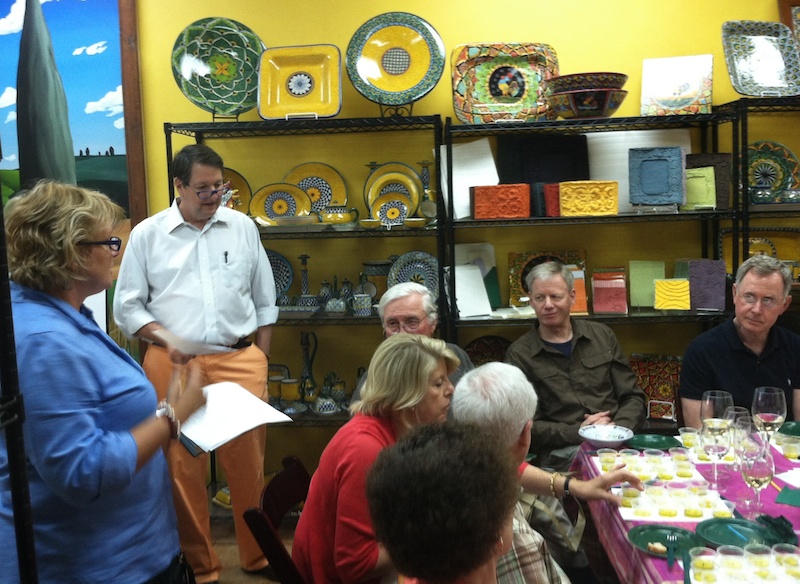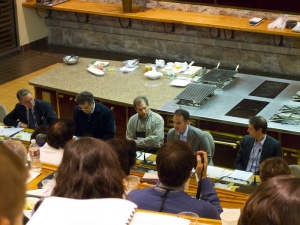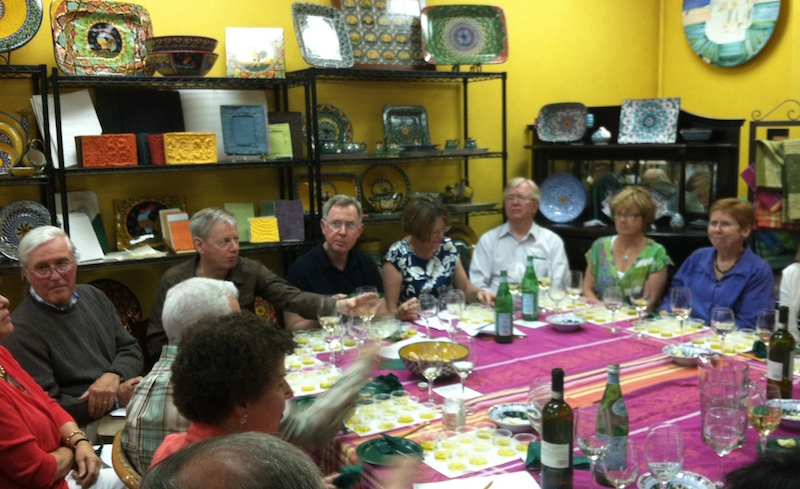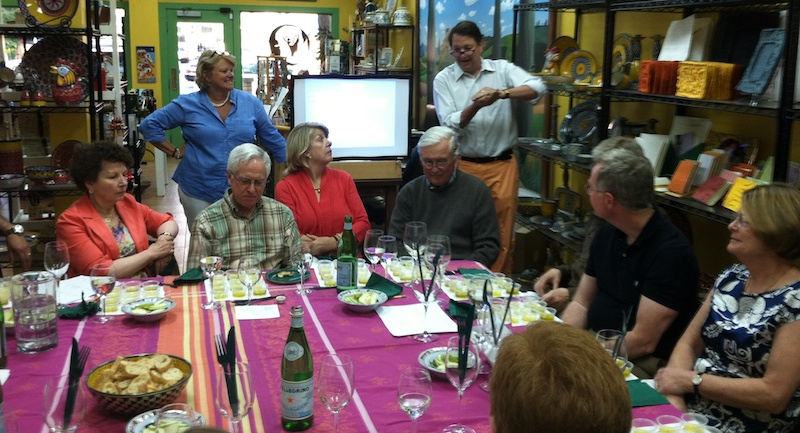
 Saturday night marked the first installment of “Olive Oil Tasting – the Bella Italia Way!” Our inauguaral group of 18 guinea pigs squeezed themselves around our makeshift tasting table, placemats set out with a dozen cups of extravirgin olive oil for tasting, drizzling and slurping. It was a tight fit at the table, but with a little EVOO slathered on our guests, everyone was easily able to slip up to the table.
Saturday night marked the first installment of “Olive Oil Tasting – the Bella Italia Way!” Our inauguaral group of 18 guinea pigs squeezed themselves around our makeshift tasting table, placemats set out with a dozen cups of extravirgin olive oil for tasting, drizzling and slurping. It was a tight fit at the table, but with a little EVOO slathered on our guests, everyone was easily able to slip up to the table.
Our love of olive oil is one of the things that led us to open Bella Italia a decade ago. We “discovered” this essential ingredient – despite the fact that Mediterranean folks have been cooking with it, flavoring with it, rubbing it on their naked bodies and washing their hair with it quite out in the open for millennia – during a series of cooking classes in the beautiful seaside village of Portovenere, a stone’s throw or at least a ferry ride away from the famous Cinque Terre fishing villages of the Ligurian coast. It was there that it finally clicked with us. Excellent extravirgin olive oil can transform just about anything it comes into contact with. It is a veritable culinary philosopher’s stone.
For the past decade we have been expanding our offerings of EVOOs, region by region, family by family, bringing back to Bella Italia only those oils that we thought possessed two essential characteristics – outstanding flavor profiles representative of the region from which they come and oils with a story and a family behind them. Our modus operandi? Find an oil we like (in a restaurant, through friends and the like), meet the producers, experience the production and then import. This has guaranteed quality oil in a world where the term extravirgin may have about as much credibility as the term virgin. It has also meant wonderful, long-lasting friendships with people who love the land, respect nature and have a singular passion for olive oil.
* * *

Over the past year our personal love of and everyday use of olive oil has deepened, as the glistening green fat has captured the popular imagination of the broader culture. Earlier this year Suzy, our son Austin and I participated in an all day seminar at the Culinary Institute of America (Napa campus) on the issue of olive oil quality and flavors. There at the CIA, we heard from producers and importers from around the world discussing issues relating to olive oil – its magical, and I do mean nearly supernatural health benefits, the myriad ways in which and where it is and can be produced, and, most importantly, how to tell a good olive oil from a bad one. Even when they both proclaim themselves extravirgin.

The fascinating story of olive oil – where it came from, its role in Mediterranean cultures and its history of fraud, deception and adulteration – is told in author Tom Mueller’s fascinating best seller Extravirginity. Wanting to learn more about the topic and being an oliocentric organization, our monthly Bella Italia book club tackled Mueller’s book last month. It was a page turner, even if the pages kept slipping through our fingers.
* * *
So armed with a newly energized appreciation for olive oil we decided to inaugurate a series of informal olive oil tasting evenings to provide the novice and the passionate groupie the same opportunity to grapple with a few central questions. What is extravirgin olive oil? What does it taste like, what should it taste like and how do I/should I use it? And most importantly, what separates a good extravirgin olive oil from what the CIA panelists called “junk”? And so on Saturday night we began our two hour seated journey answering these questions the only way we know how. By tasting, using and discussing.

The evening was truly unique. In my ever lengthening lifetime I had never spent two hours sitting around a table drinking cups of olive oil with friends and strangers. I have done it often with other, more intoxicating liquids in my cup, but never olive oil. Yet, strangely, two hours and thirteen shots of olive oil was every bit as interesting and enjoyable as a couple hours in a Georgetown saloon. And while my stomach felt about the same the day after, drinking shots of olive oil leaves you with much less of a headache.
We started the evening with a little icebreaking which, as Suzy will tell you, means Bill blathering on. And on I did blather. About the evening’s objectives, about the definitions of extravirgin and about the various attributes and defects that professional tasters look for when evaluating olive oil. We demonstrated the payoff with one of our favorites – bruschetta (toasted bread) slathered with a couple different types of olive oil.
And then we began the tasting portion. Professional olive oil tasters (yes, there are people who are considered expert and who hole themselves up in cubicles, blind taste testing oils to determine whether they meet extravirginity’s requirement that the oil possesses no negative sensory characteristics, including rancid, musty or the always entertaining fusty. Why not busty? Dusty? Lusty? I guess those may not be considered defects.
The accepted manner of tasting an olive oil is a method called strippaggio which is means exactly what it sounds like. No one in their right mind would simply drink a cup of olive oil. It’s gross and because oil has great viscosity and surface tension, it would simply slide down your tongue and the back of your throat, hopefully stopping somewhere, without leaving any molecular traces on your taste buds. It would simply scoot right over those little bumps on your tongue like a hockey puck on ice, landing in the net of your stomach without so much as a hipcheck along the way. To induce it to linger a little – so you can taste it – you gotta strippaggio. This entails putting a little oil in the well of your tongue, rounding your lips like you’re going to whistle and drawing in several quick, slurping blasts of air. The process blasts the oil droplets apart into smaller droplets, an atomizing that sprays the oil in smaller bits over your tongue, the roof of your mouth and the back of your throat. All this slurping makes you feel a bit juvenile, like when you can’t resist sucking up through your straw the last bit of milkshake from the bottom of the glass, but it has the same effect. You can taste the oil. Every sensation, every component part. It is an epiphany.

We started with four very different olive oils – some firey and robust, some a little older and perhaps a bit tired. Some with very prominent notes of grass (a good thing in olive oil), others with tomato-ey (apologies to Dan Quayle) overtones. As we slurped (or strippaggio-ed, apologies to Danilo Quaglia) our fearless panel of 18 began to give their impressions. Like wine tasting, not everyone agreed on or could even discern various flavors. And, like wine, that is one of the wonderful things about olive oil. There are no right answers. You taste tomato, I taste tomahto. Or maybe avocado. There is a certain subjectiveness to the sense of taste and a slipperiness in using language to describe it. Especially, no pun intended, with olive oil.
For some, the exercise was an eye opener, a first. For some it was a confirmation. A real moment of pride arrived when a customer, who has been buying oils from us since our opening opined that one of the slurped oils was most likely the Sicilian oil he has been buying for a decade. Gold star.
But no one, at least no one in his right mind or no one in pants under size 60 drinks olive oil straight. The magic of this magical fruit cocktail is its ability to enhance, nay transform, the food it is added to. And so while we proceeded to slurp and analyze the flavor profiles of the evening’s 13 oils, the much more important exercise was to try them on foods. So out came a parade of morsels to be flavored with and enhanced by olio extravirgine – sliced tomatoes, a chickpea and white bean salad, a savory salad with lettuce, endive, mushroom, fennel and parmigiano, a slice of grilled salmon and a few slices of grilled filet. Everything that olive oil touched, our panel of growing experts agreed, it made better. And the food made the oil better. A marriage made in heaven (“Marriage is the union between one foodstuff and one olive oil”). Our salmon, in particular, which drew a chorus of mmmmmm’s when eaten un-oiled (unannointed?) drew chants of wow when dressed with a light EVOO from Liguria. It was so good, the transformation so universally adored we were surprised that the group didn’t break into doing the wave around the table. Universally adored, too, was a monocultivar offering from our friends at Cipolloni, an awarding-winning producer of Umbrian olive oil literally in our back yard. Indeed, the vertical tasting of Umbrian oils, to which we are quite partial, were fan favorites. But that is not the point. The point is that extravirgin olive oil comes in many different varieties and if it’s good, it’s good. You simply have to learn how to recognize good oil, how to discern it from the rancid, the fusty, the huddled masses yearning to be poured down the sink (or disposed of in a more eco-friendly manner) and then use a little imagination to pair it with the foods you deem a good fit. Just like raising kids today, there are no wrong answers. Everyone can win a trophy.
Two hours is a long time to sit and drink olive oil. But is a small amount of time to invest in educating one’s taste buds and, more importantly, one’s mind in discerning how to taste and how to use olive oil for the end of maximizing the pleasure around the table. And as our first graduating class from Bella Italia’s EVOO Academy told us, oil’s well that ends well.
Ci vediamo!
Bill and Suzy


About The Author
Related Posts
It's been a long time in the making. Well before we closed our doors in…
And so we come to the end of our 2011 Food and Wine Tour, having…